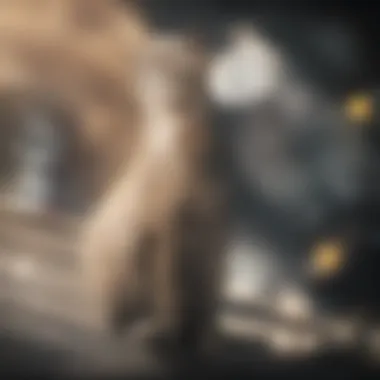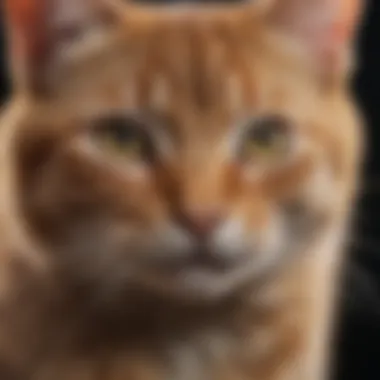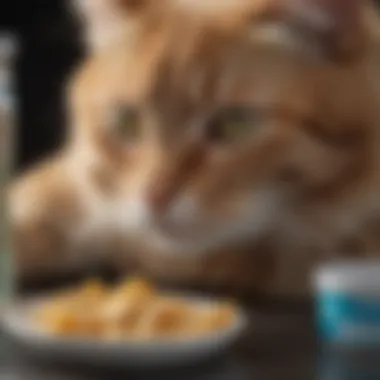Cost Analysis of Cat Gastroenteritis Treatment


Intro
Gastroenteritis in cats is a pressing concern for pet owners and veterinary professionals alike. This condition can arise from various causes, including infections, dietary changes, or exposure to toxins. Understanding the financial implications tied to treatment is essential for decision-making and responsible pet ownership. The costs associated with gastroenteritis manifest in both direct and indirect ways. This article aims to dissect these financial aspects in detail.
Summary of Objectives
The primary objective of this article is to provide a thorough understanding of the costs involved in treating gastroenteritis in cats. It seeks to inform readers about different treatment methodologies, their respective financial burdens, and the potential long-term implications that may not be immediately apparent. Furthermore, the exploration of preventative measures will highlight the value of early intervention in managing costs.
Importance of the Research
Understanding the cost analysis of gastroenteritis treatment is crucial. High veterinary bills can lead to financial strain on pet owners. By dissecting these costs, the article enables pet owners and professionals to approach treatment with better foresight.
Keeping an eye on expenses not only helps in budgeting but can also promote better health outcomes for cats. Clear knowledge of potential costs encourages timely medical attention and may prevent more severe health issues, ultimately saving money in the long run.
This analysis serves as a guide, ensuring readers are well-informed when making decisions regarding their pets' health.
Understanding Cat Gastroenteritis
Understanding cat gastroenteritis is critical for both pet owners and veterinary professionals. This condition refers to the inflammation of the stomach and intestines in cats. Due to its prevalence, recognizing and addressing this issue can help mitigate not only pet suffering but also reduce the financial burden often associated with treatment.
The discussion around gastroenteritis includes various aspects, such as identifying symptoms early and understanding common causes. Having knowledge in this area allows for timely intervention. This can lead to quicker recoveries, less time spent at the veterinarian, and lower overall costs.
Being informed about gastroenteritis can also foster better decision-making when it comes to treatments and preventative measures. Furthermore, grasping the broader implications of this condition can enhance conversations between pet owners and veterinary specialists, ensuring that care is well-coordinated and comprehensive.
Definition and Symptoms
Gastroenteritis is characterized by a combination of inflammation in the stomach and intestines. Symptoms may vary in severity but are usually recognizable. Common signs include:
- Vomiting
- Diarrhea
- Loss of appetite
- Abdominal pain or discomfort
- Lethargy
This combination of symptoms can range from mild to severe, depending on the specific situation of the cat. In some cases, gastroenteritis may resolve with minimal intervention. However, in cases where symptoms are severe or prolonged, the condition can result in dehydration or serious complications, requiring veterinary attention.
Common Causes
The causes of cat gastroenteritis are often varied and can include:
- Dietary indiscretion, such as eating spoiled food or unfamiliar substances
- Infections from viruses or bacteria
- Parasites such as Giardia or roundworms
- Stressful situations or changes in environment
Understanding these potential causes is essential for pet owners. An awareness of these factors enables them to take proactive measures, such as monitoring their cat's diet and ensuring a stable living environment.
Diagnosis Process
Diagnosing gastroenteritis in cats typically involves a thorough examination by a veterinarian. During this process, various steps are taken:


- History taking: The vet collects information about the cat's symptoms, diet, and any potential exposure to harmful substances.
- Physical examination: A hands-on assessment is conducted to check for signs of dehydration and other physical symptoms.
- Diagnostic tests: Depending on the case, your veterinarian may recommend blood work, fecal tests, or imaging like X-rays.
This examination process is essential for establishing the severity of the condition and determining the best course of treatment. Each step offers vital information that informs what is needed moving forward.
Treatment Options
Understanding the treatment options for cat gastroenteritis is crucial for pet owners and veterinary professionals alike. Timely intervention can significantly reduce the severity of symptoms and overall treatment costs. Different approaches to managing this condition include initial assessments, appropriate medications, and supportive care measures. These elements collectively contribute to a successful treatment plan, ensuring that affected cats recover efficiently while minimizing any financial burden on the owner.
Initial Assessment and Care
The first step in treating a cat with gastroenteritis is a thorough initial assessment. This process usually occurs during a visit to the veterinary clinic. Here, veterinarians perform physical examinations and may conduct blood tests or imaging studies. These procedures help to determine the underlying cause of the gastroenteritis and evaluate the cat's overall health status.
The cost of an initial assessment can vary, generally ranging from $50 to $150, depending on the complexity of the required tests. Accurate diagnosis is essential as it guides the subsequent treatment plan. Upon assessment, veterinarians may advise hospitalization if the cat is severely dehydrated or presents complications, which can increase costs significantly. It is important to understand that paying for an initial assessment can be a worthwhile investment, helping avert more severe health issues down the line.
Medications and Their Costs
Medications are often a key component of treating gastroenteritis. Depending on the diagnosis, various drugs may be prescribed. These can include antiemetics to control vomiting, antibiotics if a bacterial infection is suspected, or anti-inflammatory medications to reduce intestinal inflammation.
The costs of medications can fluctuate based on the prescribed drugs and their availability, typically averaging between $30 and $200. The total cost may increase if multiple medications are required or if specific brand-name drugs are chosen over generics. It's also important to consider that some cats may need ongoing medication if underlying conditions contribute to recurrent gastroenteritis. Hence, discussing long-term medication expenses with the veterinarian is advised.
Supportive Care: Fluids and Nutrition
Supportive care plays a pivotal role in the treatment of gastroenteritis in cats. Dehydration often accompanies this condition, making it essential for the cat to receive proper hydration. Intravenous fluids might be necessary, especially in severe cases, and these can be quite costly, potentially ranging from $100 to $300.
In addition to fluids, nutritional support is vital. After initial treatment, transitioning the cat back to a normal diet carefully can aid recovery. Veterinarians may recommend specific diets formulated to help with digestive issues, which can cost between $30 and $80 for a month’s supply.
Through adequate hydration and proper nutrition, the recovery process can be expedited, reducing the risk of complications that could lead to additional expenses. Furthermore, ensuring a cat is nourished may lead to better overall health, preventing future episodes of gastroenteritis.
"Initial assessments, appropriate medications, and supportive care are key aspects of managing cat gastroenteritis effectively."
In summary, each treatment option has inherent costs that should be understood in context. Being prepared and informed about these options can help pet owners make decisions that align with both health needs and budgetary constraints.
Cost Breakdown
Understanding the cost breakdown for treating cat gastroenteritis is essential for pet owners. This section will delve into veterinary fees, regional cost variations, and additional procedures that may be required during treatment. By examining these components, pet owners can make informed decisions and develop a more accurate financial plan.
Average Veterinary Fees
Veterinary fees for treating gastroenteritis in cats can vary. Generally, pet owners might pay anywhere from $200 to $800 for a complete examination and treatment. The fee usually includes diagnostic tests, medications, and initial care. The exact cost depends on several factors:
- Clinic Type: Private practices may charge differently than animal hospitals. Typically, animal hospitals offer more comprehensive services but may have higher fees.
- Examination Fees: The average examination fee can range from $50 to $100. This cost is often a basic charge when first visiting a vet.
- Diagnostic Tests: Blood tests, ultrasounds, or X-rays can quickly increase expenses. Blood panels may cost an additional $75 to $150, while imaging can range from $100 to $500.
In many cases, treatment costs can escalate due to the need for diagnostics or hospitalization.


Cost Variations by Region
Regional differences significantly affect veterinary costs. Urban areas often have higher living costs, which translates to increased veterinary fees. For example:
- Cities: In larger metropolitan locations, such as New York City or Los Angeles, veterinary fees can be about 20% to 50% higher than in suburban or rural areas.
- Rural Areas: Smaller towns may offer lower costs, sometimes 30% cheaper. However, fewer specialized veterinary clinics may limit options for advanced care.
- Country Variance: Different countries also present varied pricing. In the UK, treatment may be more expensive due to higher general costs but may include national health schemes or insurance that offset these costs.
Additional Procedures That May Be Required
Cats diagnosed with gastroenteritis may need additional procedures, increasing overall treatment costs. Some potential additional treatments are:
- Fluid Therapy: Administering fluids intravenously can cost $100 to $300, depending on the length of treatment.
- Nutritional Support: Specific diets for recovery might be recommended. Specialty food can cost around $30 to $80 per bag, and it's often crucial for rapid recovery.
- Hospitalization: In severe cases, where the cat needs close monitoring or advanced care, hospitalization could add $500 to $1,500 to the treatment costs.
Understanding these additional procedures is crucial to preparing for unexpected expenses during treatment.
Long-term Financial Considerations
Understanding the long-term financial implications of cat gastroenteritis treatment is crucial for pet owners. This condition, while often manageable in the short term, may require ongoing attention and care. Thus, the economic burden can extend beyond immediate treatment costs, leading to significant financial commitments over time.
Regular monitoring and potential recurring costs should be addressed. Cats recovering from gastroenteritis often need follow-up visits and treatments. These recurring treatments can escalate swiftly, depending on the severity of the condition and the cat's overall health. Owners should consider budgeting for these expenses.
Recurring Treatment Costs
Recurring treatment costs can arise in several scenarios. Even after the initial treatment, cats may need regular check-ups to ensure their recovery progresses properly. Many veterinarians recommend follow-up appointments within a few weeks after the initial care.
The types of costs that might recur include:
- Consultation fees: Regular vet visits can range from $50 to $150 each, depending on the clinic's location and the specific services provided.
- Medications: Ongoing medications for nausea or digestive aid can add to the total cost. Prices for prescription medications can vary considerably, often from $20 to $100 per month.
- Specialized diets: Cats recovering from gastroenteritis might require special diets. These diets can cost more than regular cat food, often up to $50 monthly.
These costs can accumulate, leading to a continuous financial obligation for the pet owner.
Potential Complications and Costs
Potential complications from gastroenteritis can further complicate finances. Some cats may develop chronic issues following an episode, leading to more serious health concerns. Complications such as dehydration, liver issues, or even secondary infections bring about further treatment costs.
Owners should be cautious of:
- Emergency visits: If complications arise, emergency vet visits may be necessary. Costs for emergency care can be significantly higher, with fees starting around $150 and quickly increasing with additional treatments.
- Extended hospital stays: If a cat needs hospitalization for severe dehydration or other issues, the cost can rise dramatically. Daily rates at a veterinary hospital can be between $100 and $500, depending on the location and care required.
- Long-term care needs: Chronic conditions can result from initial gastroenteritis. Ongoing treatments for such conditions may include regular medications, special diets, or frequent vet visits, leading to a sustained financial impact.
It's important to remember that prevention is always better than cure. Regular vet visits and a proper diet can help reduce the likelihood of recurrence.
In summary, long-term financial considerations related to cat gastroenteritis treatment encompass both recurring treatment costs and potential complications. Pet owners must be prepared for these ongoing expenses as they navigate the recovery process.
Preventive Measures


Preventive measures are critical in managing cat gastroenteritis. Focusing on prevention can not only reduce the occurrence of this condition but also mitigate the financial burden associated with treatment. By investing time and resources into preventative strategies, pet owners can enhance their cat's health and overall quality of life.
Importance of Regular Vet Check-ups
Regular veterinary check-ups are paramount for the early detection and management of health issues in cats. These appointments allow for comprehensive health assessments. A veterinarian can identify potential risks before they develop into serious problems. Regular exams may include vaccinations, parasite control, and dental care. Each of these components plays a role in maintaining a cat's digestive health. It is essential to establish a consistent schedule with a vet, ideally once a year, or more frequently if the cat has existing health issues. The cost of preventative care is generally lower than treating an acute episode of gastroenteritis.
Dietary Considerations
Diet plays a significant role in preventing gastroenteritis. Cats require a balanced diet that meets their nutritional needs. A sudden change in diet can trigger gastrointestinal upset. Feeding consistent, high-quality food helps maintain digestive health. It’s also important to be cautious about feeding human food, as certain foods may be harmful to cats. Additionally, ensuring that fresh water is available can prevent dehydration, a common risk factor in gastroenteritis cases.
Maintaining a healthy weight through proper nutrition can also minimize the risks associated with gastroenteritis. Obesity can lead to various health complications, including digestive issues.
Insurance and Financial Aid
Understanding the financial dimensions of treating cat gastroenteritis is essential for responsible pet ownership. Medical costs can escalate quickly, making it critical to consider insurance and financial aid options. These resources can mitigate the burden on pet owners and help ensure that necessary treatments are accessible.
Understanding Pet Insurance Policies
Pet insurance is a key component of planning for unexpected veterinary costs. Unlike human health insurance, pet insurance operates under a reimbursement model. Pet owners pay upfront for treatments and later submit claims to the insurance company. As such, it is vital to choose a policy that aligns with one’s needs.
When selecting a policy, consider the following factors:
- Coverage Types: Some policies cover accidents and illnesses, while others may only include accidents. It’s important to read the fine print.
- Exclusions: Some pre-existing conditions or specific treatments may not be covered. Understanding these exclusions prevents surprises when a claim is submitted.
- Deductibles and Premiums: Balancing monthly costs against potential out-of-pocket expenses is essential. Some owners prefer lower premiums with higher deductibles, while others may favor higher premiums with lower deductibles.
Available Financial Aid Resources
Pet owners facing financial challenges are not without options. Several organizations and resources can assist in covering veterinary expenses:
- Non-Profit Organizations: Groups such as The Pet Fund and the RedRover Relief Program provide financial assistance to pet owners who qualify. They often focus on emergency care or specific conditions, including gastroenteritis.
- Veterinary Schools: Many veterinary schools offer reduced-cost services through teaching hospitals. This can be especially beneficial for treatments requiring extensive care under supervision.
- Payment Plans: Some veterinary clinics offer payment plans, allowing pet owners to spread costs over time. This option can relieve immediate financial pressure.
- Crowdfunding Platforms: Websites such as GoFundMe can be used to raise money for unexpected pet expenses. Sharing stories through social media can increase the chances of funding.
"Considering insurance and financial aid can be a lifeline for pet owners, ensuring the welfare of their feline companions without crippling their finances."
In summary, exploring insurance and financial aid is crucial in managing the costs associated with treating cat gastroenteritis. By understanding the available resources, pet owners can make informed decisions that enhance the well-being of their pets while minimizing financial strain.
The End
Understanding the financial implications of treating cat gastroenteritis is crucial for both pet owners and veterinary professionals. The costs associated with diagnosis, treatment, and follow-up care can be substantial, impacting pet owners' budgets. Therefore, having a clear grasp of these expenses helps in making informed decisions concerning veterinary care.
Summary of Cost Factors
When analyzing the costs linked to cat gastroenteritis treatment, several factors necessitate attention:
- Veterinary Fees: Initial consultations often come with a set fee. Follow-up consultations may incur additional costs.
- Diagnostics: Blood tests, imaging, and fecal examinations add to the expense, depending on what the vet deems necessary.
- Medications: The type of medications prescribed can vary. Some conditions may require a combination of treatments, further escalating costs.
- Supportive Care: Providing fluids or specialized diets is another financial consideration.
- Regional Variations: The costs for veterinary care can differ vastly by location, with urban areas often being more expensive than rural settings.
These elements, among others, form the intricate financial landscape of gastroenteritis treatment. Recognizing these factors enables better financial planning and preparedness for unexpected expenses.
Final Thoughts on Financial Planning
Proper financial planning can mitigate the burdens associated with veterinary care costs. Some important strategies to consider include:
- Pet Insurance: Exploring comprehensive insurance options can offset some of the financial impacts. Various policies cover a range of treatments but require thorough investigation to find the best fit.
- Emergency Funds: Consider setting aside a dedicated fund for unexpected veterinary costs. This proactive measure can relieve stress during emergencies.
- Open Communication with Vets: Regular discussions about treatment costs and alternatives with vets can help manage expenses effectively.















